
This is the Title of the Book, eMatter Edition
Copyright © 2004 O’Reilly & Associates, Inc. All rights reserved.
313
Chapter 8
CHAPTER 8
Choosing a Platform for the Best
Performance
Before you start to optimize your code and server configuration, you need to con-
sider the demands that will be placed on the hardware and the operating system.
There is no point in investing a lot of time and money in configuration tuning and
code optimizing only to find that your server’s performance is poor because you did
not choose a suitable platform in the first place.
Because hardware platforms and operating systems are developing rapidly, the fol-
lowing advisory discussion must be in general terms, without mentioning specific
vendors’ names.
Choosing the Right Operating System
This section discusses the characteristics and features you should be looking for to
support a mod_perl-enabled Apache server. When you know what you want from
your OS, you can go out and find it. Visit the web sites of the operating systems that
interest you. You can gauge users’ opinions by searching the relevant discussions in
newsgroup and mailing-list archives. Deja (http://deja.com/) and eGroups (http://
egroups.com/) are good examples. However, your best shot is probably to ask other
mod_perl users.
mod_perl Support for the Operating System
Clearly, before choosing an OS, you will want to make sure that mod_perl even runs
on it! As you will have noticed throughout this book, mod_perl 1.x is traditionally a
Unix-centric solution. Although it also runs on Windows, there are several limita-
tions related to its implementation.
The problem is that Apache on Windows uses a multithreaded implementation, due
to the fact that Windows can’t use the multi-process scheme deployed on Unix plat-
forms. However, when mod_perl (and thereby the Perl runtime) is built into the
,ch08.23493 Page 313 Thursday, November 18, 2004 12:39 PM

This is the Title of the Book, eMatter Edition
Copyright © 2004 O’Reilly & Associates, Inc. All rights reserved.
314 |Chapter 8: Choosing a Platform for the Best Performance
Apache process, it cannot run multithreaded, because before Version 5.8.0 the Perl
runtime wasn’t thread-safe.
What does this mean for you? Well, essentially it means that your Apache process
will be able to serve only one request at a time, just like when using httpd -X.Of
course, this becomes a severe performance hit, making you unable to have more than
one user receiving a page at a time. The situation is resolved in mod_perl 2.0, how-
ever, thanks to advances in both Apache and Perl, as described in Chapter 24. Fur-
thermore, you can still use mod_perl on Windows for development, although you
should follow the considerations below when choosing the production OS.
Stability and Robustness
Probably the most important features in an OS are stability and robustness. You are
in an Internet business. You do not keep normal 9 A.M. to 5 P.M. working hours like
many conventional businesses you know. You are open 24 hours a day. You cannot
afford to be offline, because your customers will go shop at another service like yours
(unless you have a monopoly). If the OS of your choice crashes every day, first do a
little investigation. There might be a simple reason that you can find and fix. How-
ever, there are OSes that won’t work unless you reboot them twice a day. You don’t
want to use an OS of this kind, no matter how good the OS’s vendor sales depart-
ment is. Do not follow flush advertisements—follow developers’ advice instead.
Generally, people who have used an OS for some time can tell you a lot about its sta-
bility. Ask them. Try to find people who are doing similar things to what you are
planning to do; they may even be using the same software. There are often compati-
bility issues to resolve, and you may need to become familiar with patching and com-
piling your OS.
Good Memory Management
You want an OS with a good memory-management implementation. Some OSes are
well known as memory hogs. The same code can use twice as much memory on one
OS compared to another. If the size of the mod_perl process is 10 MB and you have
tens of these processes running, it definitely adds up!
Avoiding Memory Leaks
Some OSes and/or their libraries (e.g., C runtime libraries) suffer from memory leaks.
Aleak is when some process requests a chunk of memory for temporary storage but
then does not subsequently release it. The chunk of memory then won’t be available
for any purpose until the process that requested it dies. You cannot afford such
leaks. A single mod_perl process sometimes serves thousands of requests before it
terminates; if a leak occurs on every request, the memory demands could become
,ch08.23493 Page 314 Thursday, November 18, 2004 12:39 PM

This is the Title of the Book, eMatter Edition
Copyright © 2004 O’Reilly & Associates, Inc. All rights reserved.
Choosing the Right Operating System |315
huge. Of course, your code can be the cause of the memory leaks as well, but that’s
easy to detect and solve. Certainly, you can reduce the number of requests to be
served over the process’s life, but that can degrade performance. When you have so
many performance concerns to think about, do you really want to be using faulty
code that’s not under your control?
Memory-Sharing Capabilities
You want an OS with good memory-sharing capabilities. If you preload the Perl
modules and scripts at server startup, they are shared between the spawned children
(at least for part of a process’s life—memory pages can become “dirty” and cease to
be shared). This feature can vastly reduce memory consumption. Therefore, you
don’t want an OS that doesn’t have memory-sharing capabilities.
The Real Cost of Support
If you are in a big business, you probably do not mind paying another $1,000 for
some fancy OS with bundled support. But if your resources are low, you will look for
cheaper or free OSes. Free does not mean bad. In fact, it can be quite the opposite—
some of the free OSes have the best support available.
This is easy to understand—most people are not rich and will try to use a cheaper or
free OS first if it does the work for them. If it fits their needs, they will keep using it
and eventually come to know it well enough to be able to provide support for others
in trouble. Why would they do this for free? One reason is the spirit of the first days
of the Internet, when there was no commercial Internet and people helped each
other because someone else had helped them first. We were there, we were touched
by that spirit, and we are keen to keep that spirit alive.
Nevertheless, we are living in a material world, and our bosses pay us to keep the sys-
tems running. So if you feel that you cannot provide the support yourself and you do
not trust the available free resources, you must pay for an OS backed by a company to
which you can turn in case of problems. Insufficient support has often been character-
ized as an important drawback of open source products, and in the past it may have
been the main reason for many companies to choose a commercial product.
Luckily, in recent years many companies have realized how good the open source
products are and started to provide official support for these products. So your sug-
gestion of using an open source operating system cannot be dismissed solely on the
basis of lacking vendor support; most likely you will be able to find commercial sup-
port just like with any other commercial OS vendor!
Also remember that the less money you spend on an OS and software, the more you
will be able to spend on faster and stronger hardware. Of course, for some companies
money is a non-issue, but there are many companies for which it is a major concern.
,ch08.23493 Page 315 Thursday, November 18, 2004 12:39 PM

This is the Title of the Book, eMatter Edition
Copyright © 2004 O’Reilly & Associates, Inc. All rights reserved.
316 |Chapter 8: Choosing a Platform for the Best Performance
Discontinued Products
You might find yourself in a position where you have invested a lot of time and
money into developing some proprietary software that is bundled with the OS you
chose (say, writing a mod_perl handler that takes advantage of some proprietary fea-
tures of the OS and that will not run on any other OS). Things are under control, the
performance is great, and you sing with happiness on your way to work. Then, one
day, the company that supplies your beloved OS goes bankrupt (not unlikely nowa-
days), or they produce a newer, incompatible version and decide not to support the
old one (it happens all the time). You are stuck with their early masterpiece, no sup-
port, and no source code! What are you going to do? Invest more money into port-
ing the software to another OS?
The OSes in this hazard group tend to be developed by a single company or organiza-
tion, so free and open source OSes are probably less susceptible to this kind of prob-
lem. Their development is usually distributed between many companies and
developers, so if a person who developed a really important part of the kernel loses
interest in continuing, someone else usually will pick up the work and carry on. Of
course, if some better project shows up tomorrow, developers might migrate there and
finally drop the development, but in practice people are often given support on older
versions and helped to migrate to current versions. Development tends to be more
incremental than revolutionary, so upgrades are less traumatic, and there is usually
plenty of notice of the forthcoming changes so that you have time to plan for them.
Of course, with the open source OSes you have the source code, too. You can always
have a go at maintaining it yourself, but do not underestimate the amount of work
involved.
Keeping Up with OS Releases
Actively developed OSes generally try to keep pace with the latest technology devel-
opments and continually optimize the kernel and other parts of the OS to become
better and faster. Nowadays, the Internet and networking in general are the hottest
topics for system developers. Sometimes a simple OS upgrade to the latest stable ver-
sion can save you an expensive hardware upgrade. Also, remember that when you
buy new hardware, chances are that the latest software will make the most of it.
If a new product supports an old one by virtue of backward compatibility with previ-
ous products of the same family, you might not reap all the benefits of the new prod-
uct’s features. You might get almost the same functionality for much less money if
you were to buy an older model of the same product.
,ch08.23493 Page 316 Thursday, November 18, 2004 12:39 PM

This is the Title of the Book, eMatter Edition
Copyright © 2004 O’Reilly & Associates, Inc. All rights reserved.
Choosing the Right Hardware |317
Choosing the Right Hardware
Sometimes the most expensive machine is not the one that provides the best perfor-
mance. Your demands on the platform hardware are based on many aspects and
affect many components. Let’s discuss some of them.
This discussion relies on the specific definitions of various hardware and operating-
system terms. Although you may be familiar with the terms below, we have explic-
itly provided definitions to make sure there is no ambiguity when we discuss the
hardware strategies.
Cluster
A group of machines connected together to perform one big or many small com-
putational tasks in a reasonable time. Clustering can also be used to provide
failover, where if one machine fails, its processes are transferred to another with-
out interruption of service. And you may be able to take one of the machines
down for maintenance (or an upgrade) and keep your service running—the main
server simply will not dispatch the requests to the machine that was taken down.
Load balancing
Say that users are given the name of one of your machines, but it cannot stand
the heavy load. You can use a clustering approach to distribute the load over a
number of machines (which gives you the advantages of clustering, too). The
central server, which users access initially when they type the name of your ser-
vice into their browsers, works as a dispatcher. It redirects requests to other
machines, and sometimes the central server also collects the results and returns
them to the users.
Network Interface Card (NIC)
A hardware component that allows your machine to connect to the network. It
sends and receives packets. NICs come in different speeds, varying from 10
MBps to 10 GBps and faster. The most widely used NIC type is the one that
implements the Ethernet networking protocol.
Random Access Memory (RAM)
The memory that you have in your computer (comes in units of 8 MB, 16 MB,
64 MB, 256 MB, etc.).
Redundant Array of Inexpensive Disks (RAID)
An array of physical disks, usually treated by the operating system as one single
disk, and often forced to appear that way by the hardware. The reason for using
RAID is often simply to achieve a high data-transfer rate, but it may also be to
get adequate disk capacity or high reliability. Redundancy means that the system
is capable of continued operation even if a disk fails. There are various types of
RAID arrays and several different approaches to implementing them. Some sys-
tems provide protection against failure of more than one drive and some (“hot-
swappable”) systems allow a drive to be replaced without even stopping the OS.
,ch08.23493 Page 317 Thursday, November 18, 2004 12:39 PM

![Đề cương thi trắc nghiệm Lập trình có cấu trúc [năm] chuẩn nhất](https://cdn.tailieu.vn/images/document/thumbnail/2025/20250924/kimphuong1001/135x160/4331758683749.jpg)







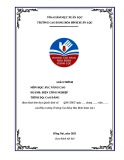

![Tài liệu ôn tập môn Lập trình web 1 [mới nhất/chuẩn nhất]](https://cdn.tailieu.vn/images/document/thumbnail/2025/20251208/hongqua8@gmail.com/135x160/8251765185573.jpg)



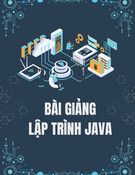
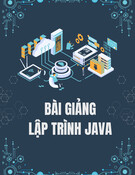
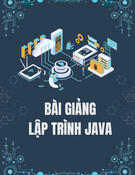
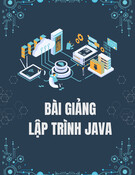
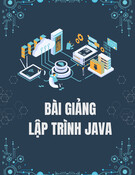

![Hệ thống quản lý cửa hàng bán thức ăn nhanh: Bài tập lớn [chuẩn nhất]](https://cdn.tailieu.vn/images/document/thumbnail/2025/20251112/nguyenhuan6724@gmail.com/135x160/54361762936114.jpg)
![Bộ câu hỏi trắc nghiệm Nhập môn Công nghệ phần mềm [mới nhất]](https://cdn.tailieu.vn/images/document/thumbnail/2025/20251111/nguyenhoangkhang07207@gmail.com/135x160/20831762916734.jpg)



